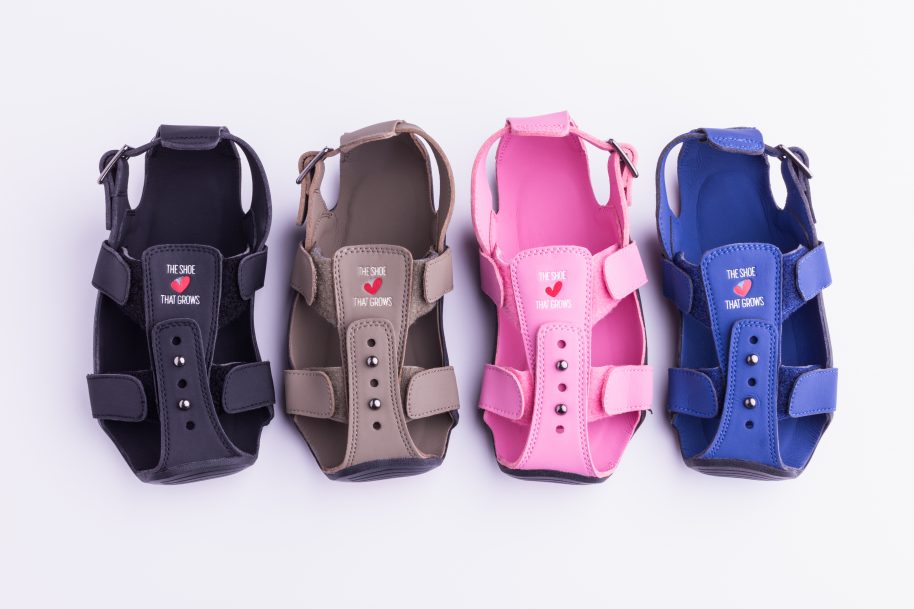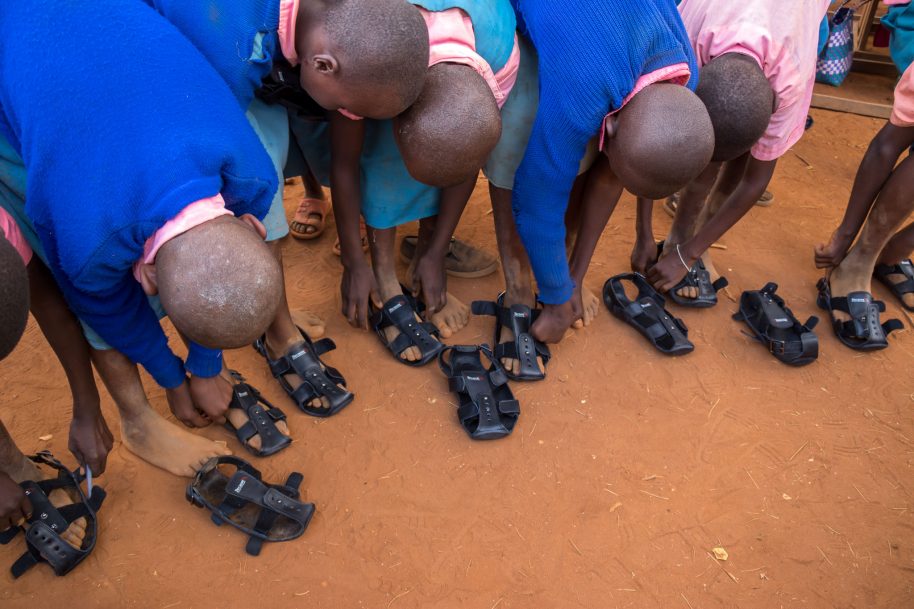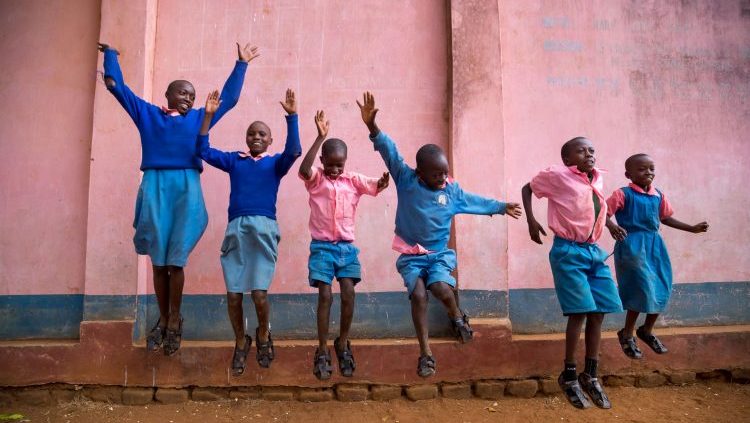Photo: Provided by The Shoe That Grows
Right after college in 2007, I was traveling and volunteering for about a year. In Kenya, I was working at a small orphanage right outside of Nairobi. I was about a month into my time there and the kids and I were all walking down this dusty road, it was a super hot day, and walking next to me was a little girl, probably eight or nine years old in a white dress. As I looked down, I was shocked by how small her shoes were. Her shoes were way too small for her feet. She actually had to cut open the front to let her toes stick out. I looked around and a lot of the kids had either no shoes or similar shoes that were way too small and cut open in front. That was the day that I had an idea for a shoe that could adjust and expand in size, a shoe that could grow.
Shoes are small things that make a big difference. Shoes are not just for fashion. Their first function is really to protect the feet. There are certain parasites and worms that can enter the body through the feet. If kids have no shoes and they get a cut or a scrape, they are now open and susceptible to these different diseases. In Uganda and in other parts of East Africa, there’s a small bug called a ‘jigger’ and it gets on their feet and it kind of eats away at their flesh. If you have shoes, then your feet can be protected. Besides health, in many areas, kids have to wear a mandatory uniform to school and often shoes are a required part of that uniform. If kids don’t have shoes, they can’t go to school.
My whole goal from the very beginning was: how can we have a very functional shoe to protect these feet for longer? How can we take one pair and allow them to adjust it so it can keep on fitting?
It took six years to work on this. I got back home to Nampra, Idaho. The first thing I did, I tried to give the idea away. I didn’t know a thing about shoes so I contacted all the major shoe companies, but everybody said no, told me it wasn’t a good idea. Then I tried it on my own. I went out to the garage and took a bunch of shoes I bought at a thrift store and for months I was cutting them up and gluing them together and trying to make some kind of a prototype. (If you are ever in Idaho and come to our office, you can see the world’s worst shoe prototypes that I made.) Finally, we found a small shoe design company in Portland, Oregon called Proof of Concept. They loved what we were trying to do. They took us on about a year-long design journey to get us to a prototype.

We did a little bit of fundraising and were able to make 100 pairs of the prototype and take them back to Kenya, put them in 400 schools around the country and had kids test them out for about a year. From that testing, we developed our first batch of 3,000 pairs.
This was always just a passion project for me. I always thought it would be a small hobby until April of 2015, when we had an article on BuzzFeed. We accidentally went viral. Things changed overnight for us. I sold out of shoes that day. I had about 3,000 emails, about 500 phone calls. Over the next couple weeks, we had over $100,000 in donations come in.
We really pride ourselves on the durability of our shoes. The shoes are made of two really simple materials. The bottom is a compressed rubber, really similar to a tire rubber. Very durable, very strong. The rest of the shoe is a high quality synthetic leather. It does great in wet conditions, in the rain, in rivers and lakes. It’s a shoe-sandal hybrid so we didn’t make it for cold weather, but in any warm weather country, our shoes do a fantastic job.
Even though we don’t distribute ourselves, I’ve been able to do it four times and just love it every single time. The kids are so appreciative. For many of these kids, it’s the first pair of shoes they’ve ever had. The most meaningful thing for me from that first distribution in Kenya was the parents’ reaction, just being so impressed and amazed with how sturdy and solid the shoes were. When I showed them how they could grow, a light bulb would go off. They got it. They saw how meaningful this was for a pair of shoes that can grow with their child’s foot so that that foot can stay protected, that child can be a little bit more healthy, can attend school more often, can be more confident. Now that I’m a parent, I totally get it. Anything we can do to put our kids in a position to succeed.
But we need people to get involved. We rely on connecting with anybody who works with kids: churches that go on trips and work with kids, organizations that work with kids, schools, rotary clubs, anybody who is working with kids around the world or even locally. If anybody wants to help with distribution, we love when people take our shoes and distribute them to the kids that they work with.
For anybody who’s not working with kids or going on trips, that’s OK, we are a non-profit organization and we love accepting donations and support to help sponsor shoes for other people to take them to the kids that they work with.

We’re doing our biggest program of the year for our donors, a really cool program called Wear a Pair. People can sign up right now and in April they can wear a pair of our shoes and share it with their friends and family, share on social media, and fundraise for a specific group of kids. They can do that as a family, an individual, a workplace, or whatever. We’re trying to get 300 people signed up. We’ve got 300 different groups of kids in Kenya that have asked for sponsorship so we’re trying to get people to ‘wear a pair’ and support these kids in Kenya and fundraise for them. That’s a great way to be involved right now.
The non-profit umbrella of The Shoe That Grows is Because International. The mission of Because International is to leverage innovation to make things better. Our goal with Because International is to be more than just a shoe. We just launched our second project, which is an innovative design for a bed net, or a mosquito net. We call it Bednet Buddy. It’s a freestanding pop-up tent, kind of a mosquito net, for kids ages 0 to 5 who don’t always sleep in a house and can’t always use a traditional bed net. We’re just getting that launched. With Because International, we hope to have several projects that we’ve created and are getting out there.
We’re also committed to using the production of our products to bring as many jobs as possible. We were able to bring 30 jobs in 2017 through the production of our shoes in Ethiopia. We have a factory in Haiti working on a sample for us. We hope to one day be producing our shoes in several world areas and bringing as many jobs as we can.
I thought I was going to be a missionary. That was the first reason I traveled. And even though I loved to travel, I missed home too much. I missed Idaho. I missed America. I thought, ‘I cannot live overseas for the rest of my life.’ When I got back, I was a pastor. I really enjoyed doing that. This was just going to be a hobby and my way of trying to help out a little bit. But then it accidentally took off. And now I love it. I love being a part of this. We have an incredible team of ten full-time people who work with me and really do the bulk of the work. I just get to go out and tell true stories. I never, ever thought this would be my full-time job and I never thought we’d be where we are today.
Kenton Lee is the founder of The Shoe That Grows, the first project of non-profit Because International, which makes children’s shoes that expand five sizes. The Shoe That Grows has provided over 150,000 pairs of shoes to kids in almost 100 countries since its inception.









